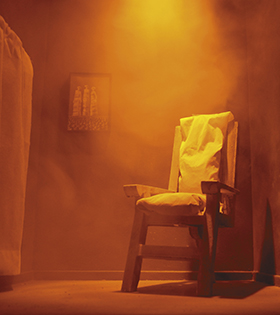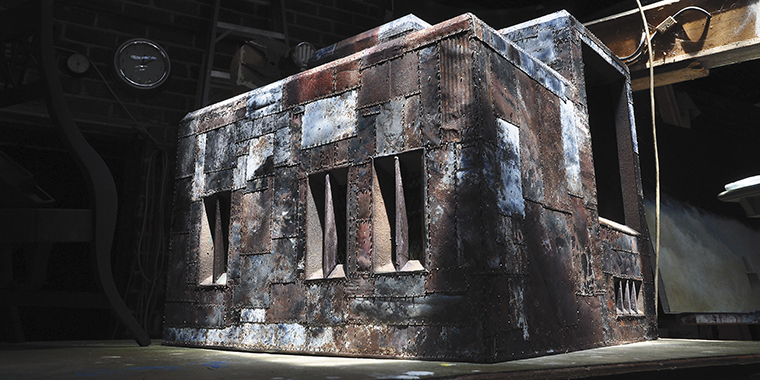 Turning away from teaching
Turning away from teaching
Words by June Moorhouse
April 2013
Stuart Elliott’s arts education started in the bush, making wood and clay constructions from the bits and pieces gathered during his childhood meanderings, as well as hours alone drawing, painting and making because he was a ‘crook kid’ and missed a lot of school.
It was a pretty good start but as Stuart observes, art wasn’t something that, in the 50s and 60s, was thought to provide a reliable future so off he went, like many others, to do a trade before heading to the desert for work.
But as soon as the opportunity arose to seriously pursue art, he did. And that came with the introduction of free tertiary education under the Whitlam Government, which allowed Stuart to enrol at Claremont School of Art. The Diploma he achieved there gave him entry to the final two years of the degree course at Curtin University of Technology.
I asked Stuart what he got out of his studies? “The most important thing at Claremont was that if you’re making stuff on your own you don’t see someone using something and get to ask, ‘what are you doing with that?’, ‘what’s that stuff?’ or a version thereof. Art history was very critical and people actually setting you projects. ‘Let’s engage the idea of volume with paint’. If you’re working on your own, there’s no way you think of that sort of stuff.
“In terms of a real critical atmosphere, Claremont didn’t have any, but the really important issue was that I made, probably, lifetime connections with people. Tony Jones started teaching there the same day as I started as a student and to this day we’ve remained very good friends.
“Tony was really interested in experimental stuff, things that didn’t necessarily add up. He was interested in the enquiry. Others (at Claremont) were interested in the perfection of décor where the ultimate goal of any given artwork was its acquisition. You can’t say either of those, from a purist position, is the right way but the friction that was generated in that often quite prickly discourse was very important as a bystander.
“Curtin was very, very influential. I never got along at any point with the faculty there other than ceramics and that was really good because there was a lot of friction between what I thought art might be and what they thought art should be, so, again, that discord was terribly important.
“Probably the most important thing about a university education was, at least the subliminal realisation, that there are multiple truths which can co-exist but are significantly different.
“When I went to art school in ‘76 I just thought, ‘yeah I’m really smart and I’ve got really interesting ideas and all I really need is a bit of skill and I’ll take it from there’. And then after about six months there you think, ‘you are such a dumb arse man, you don’t know anything!’ The recognition of your own profound ignorance was probably the first step of actually being able to build something that’s worthwhile. Everyone’s life is a work in progress but for me that construction process began somewhere in the winter of ‘76.”
In the mid 80s Stuart began a teaching career in the TAFE system that has spanned more than two decades. Although he has also taught at universities, he preferred the TAFE system because of the demographic of its students. “There were lots of people who came there with copious life skills and an intellectual curiosity, however varying in talent in the classic sense.”

Stuart’s TAFE teaching experience began back at Claremont School of Art where he was drawn by his connection with Tony Jones and, one suspects, by his willingness for a stoush about the things that matter to him. By this time the tensions at Claremont had, according to Stuart, “pretty much become Beirut”. But in the midst of all that drama Stuart says he was ‘blessed’ to have lots of interaction with really good students – Simon Gilby, Merrick Belyea, Lorraine Biggs, Ricardo Peach – all people, he notes, who are still making a serious contribution.
“There’s something very important about teaching. It’s a responsibility and a privilege, but there’s also… you can’t lie to people, you’ve got to really believe in what you’re saying.” He refers to a colleague, an architect, who once said he had to do a tutorial on his own beliefs every time he went into a lecture theatre. “I’ve yet to find a better definition.”
But part way through last year Stuart decided those tutorials were over.
In hindsight, he believes the problems came to the fore with the move to Central TAFE, “It basically got managed to death. It’s too big, there’s too much investment in it and the culture of the training industry these days – not teaching, not education, but the training industry – has become so bloated and lost in its own minutiae that at best it’s turning out potential bureaucrats, you know, the next middle management people. That almost seems to be the vocational goal.
“I don’t know if you’ve seen any of the stuff that passes for documentation of delivering (TAFE) lectures but it’s stuff that people at the tax office would be scratching their heads (about). It’s not designed to fit anything in particular; it’s designed to fit everything. Schools of Art have to comply with exactly the same forms and bureaucratic over-structures as everything else. I could be presumptuous and say it probably works okay for roof plumbers or it probably works okay for joiners, but I’m not sure that it does.
“It’s become so bureaucratically intensive that, at the end of the day, the people who are going to be best suited are the people who have a bureaucratic propensity. The idea (is) that if you do your degree or diploma in business management or whatever that means you’ll be able to run a library, a nuclear power plant or an intensive care unit. Same principles hold. Well, yeah… the same principles hold between a leaf falling and a Stuka Dive Bomber, but they’re quite different things.”
Stuart acknowledges that these changes at TAFE were part of a societal shift towards a more risk averse culture, one where accountability in the form of measurement was the surest armour against potential litigation. This demand, together with the rise of managerialism and the increasing need for institutions to justify themselves economically, combined to dehumanise the system.
In the classroom, Stuart says, things could still work well and for a one-off period when he encountered a rare manager who could deal with the demands of the system as well as appreciate what was needed by the staff, teaching was enjoyable. However, increasingly, the general lack of understanding of the needs of art teaching and the requirement of dealing with “jargon drenched documents” became unworkable. Again, Stuart places this experience in the context of a broader societal fear of uncertainty in the face of accelerating change, recognising that it would be almost impossible to establish an ideal learning environment in the current circumstances.
Does he miss teaching? “I miss the interaction with good students and with good faculty… Fortunately I have a lot of art connections and a lot of good friends… I used to think, in any job I’ve done in my life, if you look at your watch twice in the day, change your job. With teaching, often, I realised the day was over when the lights in the car park came on… It was so interesting talking to people and looking at what they did. And like (his former colleague) said all those years ago, it’s like doing a tute on your beliefs every year. When you’ve said the same thing two or three times, you are conscious of it and you have to critique it.”
And then we move to the studio where Stuart’s work for the forthcoming exhibition Facility, embodies all of what we have just discussed, and so much more.
June Moorhouse has a long history of working in the arts across all sectors, in WA and nationally. She is a former journalist, Director of Fremantle Arts Centre, Australia Council Fellow and has been a consultant for 12 years.
This article featured in the Artsource Newsletter, Autumn 2013.